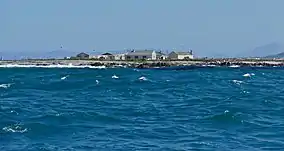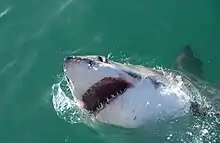Dyer Island Nature Reserve Complex
The Dyer Island Nature Reserve Complex is a protected area off the coast of Gansbaai in the Western Cape, South Africa. It consists of 3 islets, namely Dyer Island, Geyser Island, and Quoin Rock that lies 25 kilometres away from Dyer Island, off the coast of Quoin Point Nature Reserve and Agulhas National Park.[2][3][4]
| Dyer Island Nature Reserve Complex | |
|---|---|
 | |
Dyer Island and Geyser Island, off the coast of Gansbaai. And Quoin Rock off Quoin Point Nature Reserve. | |
| Location | Western Cape, South Africa |
| Nearest city | Gansbaai |
| Coordinates | 34.6829°S 19.4203°E |
| Established | March 9, 1988 |
| Governing body | CapeNature |
| Official name | Dyer Island Provincial Nature Reserve and Geyser Island Provincial Nature Reserve |
| Designated | 29 March 2019 |
| Reference no. | 528[1] |
Combined, Dyer Island and Geyser Island are a designated Ramsar site.[5]
Dyer Island is the largest in the group of islands, and lies about 8 kilometres (5.0 mi) offshore from Gansbaai and Danger Point Lighthouse. It is home to a declining colony of African penguins (≈ 5000 individuals in 2015). Geyser Island is a smaller island nearby and is home to around 60,000 brown fur seals.
The shallow channel between the two islands is popularly known as Shark Alley.
The reserve cannot be accessed by the general public.
History
The original name of Dyer Island was Ilha da Fera (Island of wild creatures), so named by Portuguese seafarers in the 15th century.
It is named after Samson Dyer, an emigrant from the US to the Cape Colony in 1806, who lived on the island collecting guano, which he sold to mainlanders as fertiliser.
In 1988, the two islands were named individually as Provincial Nature Reserves. And in 2019, the two islands were designated as a Ramsar site.
Biodiversity

.jpg.webp)
.jpg.webp)
The reserve is home to a number of threatened species. It is home to 48 bird species, of which 21 species breed here.[5][6] There are 26 species of fish found in the surrounding waters, including the endangered Galjoen.
Birds
Fish
- Galjoen
- Great white shark
Mammals
References
- "Dyer Island Provincial Nature Reserve and Geyser Island Provincial Nature Reserve". Ramsar Sites Information Service. Retrieved 20 March 2023.
- "Dyer Island Nature Reserve Complex Management Plan" (PDF).
- "Gazetted Name: Dyer Island Provincial Nature Reserve" (PDF).
- "Gazetted Name: Geyser Island Provincial Nature Reserve" (PDF).
- "Dyer Island Provincial Nature Reserve and Geyser Island Provincial Nature Reserve | Ramsar Sites Information Service". Ramsar Sites Information Service. Retrieved 20 March 2023.
- "Dyer Island Nature Reserve".